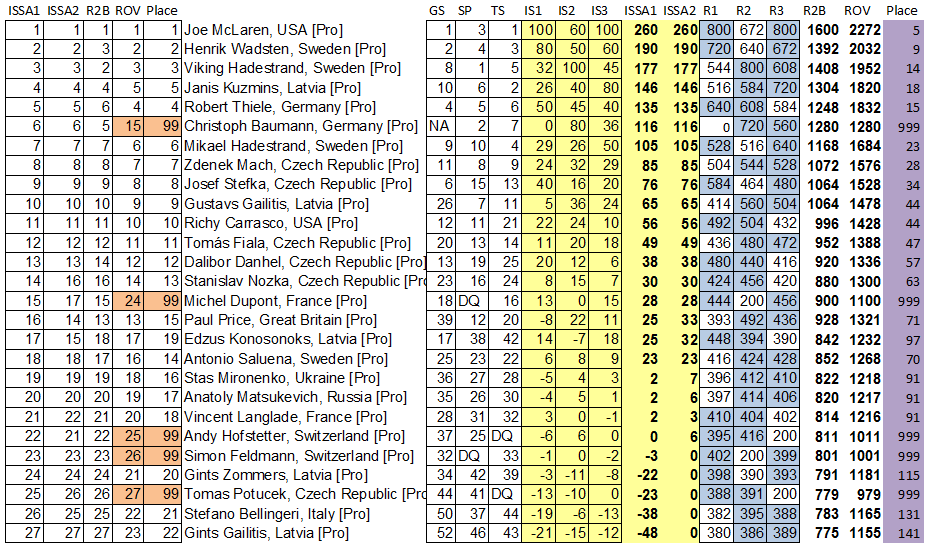Ok, I finished my research of overall points. I took the Pro class at the Worlds 2010 as research data. And it turned out to be good test data. See table below...
Explaining some of the things in the table:
First 5 column showing overall placement according two the 5 systems tested.
ISSA1: The ISSA overall point system
with minus points. Using 3 results.
ISSA2: The ISSA overall point system
without minus points. Using 3 results.
Added that those with zero total points are sorted on best placement.
R2B: Using ranking points. Using 2 best results.
ROV: Using ranking points. Using 3 results.
Place: Using the placement method. 1:st place 1 point, 2:nd place 2 points, ...
GS (Giant slalom placement)
SP (Special/hybrid slalom placement)
TS (Tight slalom placement)
IS1,IS2,IS3: Points according to ISSA overall system
ISSA1: Points using the ISSA overall point system
with minus points. Using 3 results.
ISSA2: Points using the ISSA overall point system
without minus points. Using 3 results.
R1,R2,R3: Points according to the ranking system
R2B: Points using ranking points. Using 2 best results.
ROV: Points using ranking points. Using 3 results.
Place: Points using the placement method 1:st place 1 point, 2:nd place 2 points, ...

- Cells with red color in the first 5 columns are racers that missed one event due to not attending (NA) or disqualified in one event (DQ).
- The blue cells show the 2 best results used for the overall using the 2 best results.
Conclusions
Looking at the final placements in the first five columns it's interesting to see that it is only minor differences between all the five systems actually.
The two systems with cells marked red are those that punish hard racers that do not enter or DQ in one of the three races. The Place system even DQ those racers from the overall results. The ranking system punish them hard because it differs a lot between getting normal points, getting a DQ points and not attending (getting no points).
What is fun here is that the ISSA system, event though counting all three events, does not really punish the racers very much at all. Probably because lower max points (100) that make difference between a normal points and not attending not so big.
What is interesting to see is that the "Ranking 2 best result system" (that I have always liked) almost matches the ISSA overall results exactly.
What is very unfortunate with the ISSA1 system is that a racer that does not enter a race actually can get more points (0) than a racer that enters (who can get negative points). I have always put -99 points on those when I have calculated overalls to make it work. Which means that you actually discualify the racers as you do in the "Place" method.
This is what the new BOD wanted to fix by taking away the minus points. And by doing so they suddenly boosted the points for those racers that had bad minus points results.
The ISSA system have the same punishment (0 points) for those...
- having places lower than 32 (only ISSA2 system)
- having a DQ
- not entering the race
The ranking system actually takes all this into account. And have different levels for this.
- Place 1-32 50-100% of total points
- Place 33-nnn 25-49% of total points
- DQ 25% of total points
- No attandence 0% of points
There is some fundamental questions.
1. Do we want to punish hard those who fail in one race?
- If YES: The Placement method and the Ranking counting all 3 events are the choice
- If NO: The ISSA methods or the Ranking counting 2 best events are the choice
2. Do we need to invent another overall point system? Or can we use the ranking points we already have?
Whatever the choice of the first question I conclude that we do not need any other point system than what the ranking iteslf already gives us.
It's true that the ranking points in itself does not make life easier to understand but is it really the points we need to understand? Isn't it the final placements that are important?
Have a think about this during the week. Very interesting research I think.
